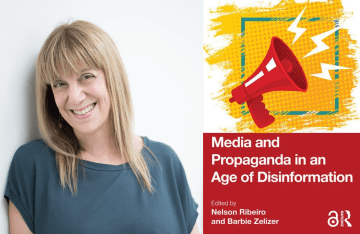New Study Finds Visuals of Vaping in E-Cigarette Advertisements Increase Anti-Vaping Beliefs and Policy Opinions
When vaping portrayals are reminiscent of cigarette smoking, viewers are likely to form negative opinions of vaping.

Photo Credit: John Caroro / Unsplash
A commercial for vaping, a tobacco-free way to consume nicotine vapor, might look like this. A mother pulls out a vaping device while standing next to her children, and a slogan appears: “It is just water! Keep Yourself & Family Healthy.”
Do ads like these convince smokers to support vaping in any location, even where smoking is forbidden? Do they make non-smokers want to start vaping?
A new study from the Annenberg School for Communication at the University of Pennsylvania found that pro-vaping advertisements like these may actually be having the opposite effect, increasing negative thoughts, feelings, and opinions toward electronic cigarettes. Published in Human Communication Research, the study shows that when vaping portrayals within commercials are reminiscent of traditional cigarette smoking, viewers are likely to associate vaping with smoking. And because many people view smoking as “wrong” or “bad” due to its detrimental health effects, this also leads them to view vaping as wrong or bad.
“When e-cigarette advertisements show people vaping in social settings, they tend to lead viewers to develop more — rather than less — support for vape-free policies,” says Doctoral Candidate Sijia Yang, lead author of the study. “The person on screen may be saying that vaping is harmless, but when a viewer sees someone ‘smoking’ in a surgery operation room, or with non-users around in a restaurant, they don’t feel good about it, even if it’s actually vapor from an e-cigarette."

For their study, the researchers recruited just under 1000 former and current smokers, and showed them real e-cigarette advertisements, most of which make explicit claims that electronic cigarettes pose very little health harm, and also show visuals of people vaping around non-users.
The participants were randomly assigned to one of three groups. The first viewed the ads exactly as they appear on television or online. A second group did not see the ads, but listened to the ads’ audio and read the audio transcripts. Both groups then answered questions like “How concerned are you that vapor from e-cigarettes could affect the health of people around you?” and “Do you agree that vaping or using e-cigarettes should be banned in places where smoking tobacco cigarettes is banned?” A control group answered the same survey questions without being exposed to any advertisements.
Participants who watched the video ads were more likely to be concerned about the secondhand health effects of vaping, and were also more likely to support policies restricting the use of e-cigarettes, when compared to those participants who only listened to the audio.
Yang says that visuals make all the difference. Because many people are morally opposed to smoking and to subjecting others — especially children or the elderly — to secondhand smoke, visuals that show vaping (which looks similar to traditional cigarette smoking) in the vicinity of non-smokers elicit negative opinions toward electronic cigarettes. But when participants didn’t see the visuals, and only heard the claims being made about the healthiness of e-cigarettes, they were much more likely to believe the advertisements.
Does that mean the ads are ineffective? That depends on the audience, says Yang.
“If you’re developing a public health campaign and your target audience is non-smokers, you might want to use those visuals likely to provoke moral outrage in your ads,” Yang says. “Our research shows that, for the purpose of prevention, such cues will likely make e-cigarettes unappealing to the viewers.”
But if the goal is to transition cigarette smokers to e-cigarettes, such visuals may not help. While consensus has not yet been completely reached, most scientists believe that e-cigarettes are less harmful than traditional cigarettes (but are not entirely harmless). Someone trying to convince smokers to switch to e-cigarettes may want to refrain from using visuals of vaping, especially in social settings, and focus instead on the reduced health harms as compared to traditional cigarettes.
“The up surge in Juuling — a form of vaping — among adolescents would seem to run counter to our findings,” says senior author Joseph Cappella, Gerald R. Miller Professor of Communication. “But the uptake in Juuling is occurring through other forms of influence than standard broadcast or online advertising, mainly through social media and peer behavior where juuling and smoking cigarettes are portrayed as sharply different.”
Other study authors include Research Director Erin Maloney and Harvard University Assistant Professor Andy Tan (Ph.D. ‘13). Click here to read the full study, “When Visual Cues Activate Moral Foundations: Unintended Effects of Visual Portrayals of Vaping within Electronic Cigarette Video Advertisements,” published in Human Communication Research.



